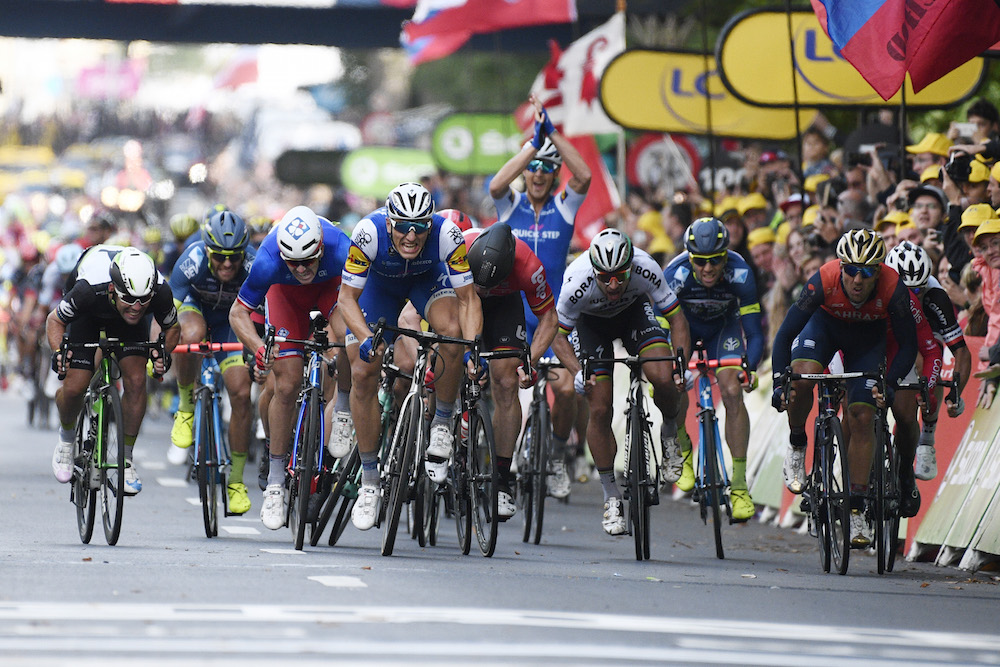‘100 per cent useless’: Pros and directors question effectiveness of new three-second rule for sprints
The new rule introduced by the UCI for the Tour de France hasn't changed much, say some of the pros and directors at the race

Marcel Kittel sprints to victory on stage two of the Tour de France (Sunada)

The new three-second rule put into place for the 2017 Tour de France to make the bunch sprints safer "is 100 per cent useless," say some. Others applaud the change.
>>> What type of Tour de France rider are you most like?
The UCI put into place a new rule for the Tour de France and other races saying that a bunch would only be split on time if the gap was timed at three seconds or more. Before, a split would be considered already at one second.
The idea is that it creates less pressure on the classification men to battle for positions with the sprinters in the final kilometres to avoid losing time.
"It's useless, 100 per cent," said Eusebio Unzué, manager at team Movistar with Nairo Quintana.
"It doesn't do what it was created to do. Sincerely, with this rule, it's the same thing as before. I'm for sure, even now that they started it, it'll be 100 per cent useless."
The UCI said that at 60kph the distance between the last rider of a group and the first of the next is 17 metres at one second. At three seconds, it is over three times more at 50 metres.
The latest race content, interviews, features, reviews and expert buying guides, direct to your inbox!
"It doesn't affect things at all. The Tour is too nervous for guys to be thinking about guys leaving gaps," said Orica-Scott head sports director Matt White.
"I don't think the rule changes makes much of a difference. It's not going to change here until the bunch sees that on days it is splitting that there is no time split. The guys see that OK, maybe I can be a little more relaxed. But the GC teams will ride the same."
"If you have a multi-million dollar rider who's going for a top GC placing in the Tour you are not going to just sit last wheel because they made a slight adjustment to the rules," Charly Wegelius, Cannondale-Drapac sports director said.
"We have to be aware of the fact that winning the Tour or winning stage races is also about being one of the best bike riders. Capable of being in the peloton and riding at the front. I don't think we should go too far and take the edges off it."
"You still can't afford to let any gap go because if it is over that three-second gap then it's more than three seconds," said Ben Swift (UAE Team Emirates).
"It goes to the front of the peloton, so you're not just losing three seconds you're losing much more, so an extra two seconds to what you would lose before.
"It's a start. It's something to make it a bit safer, but I don't think you can change much because it's a race and you can't just say GC neutralised for the final five kilometres because then it changes everything."
One rule also says that if there is a crash in the final three kilometres and a rider is involved than he will not lose time. Some argued this should be extended or that the time of the bunch should be taken at a point, say three kilometres out, and let the others sprint for the stage win.
Watch: Tour de France stage three highlights
"You need a longer distance [than the three-kilometre crash rule] because if there is a crash at four kilometres then the guys lose time if the road is blocked," Marcus Burghardt (Bora-Hansgrohe) explained.
"Create a rule of five kilometres for crashes or more and then neutralise the time for the GC riders. It's safer for everyone, you saw that in the Tour de Suisse when they did so, it was much safer for the sprinters to do their job."
"Maybe the new rule should be 10 seconds before it is considered a gap!" sprinter Alexander Kristoff (Katusha-Alpecin) said.
"Maybe they should consider neutralising the final three kilometres. It would be strange, but that's a suggestion.
"[The new rule] helps for the GC guys and helps for the sprinters. They should be less nervous because they have a bigger gap now, 50 metres. But let's see."
"This is better than before even if three seconds is small," said Daniele Bennati, domestique for Quintana. "It's good that GC men can relax a bit before and avoid those crashes and us helpers can stay a little calmer.
"Still, it's clear that we have to always stay attentive because we can't allow a gap for Quintana. If you are in the first 25, it's difficult that you get caught out, but that's stressful to stay there."

Thank you for reading 20 articles this month* Join now for unlimited access
Enjoy your first month for just £1 / $1 / €1
*Read 5 free articles per month without a subscription

Join now for unlimited access
Try first month for just £1 / $1 / €1
Gregor Brown is an experienced cycling journalist, based in Florence, Italy. He has covered races all over the world for over a decade - following the Giro, Tour de France, and every major race since 2006. His love of cycling began with freestyle and BMX, before the 1998 Tour de France led him to a deep appreciation of the road racing season.
